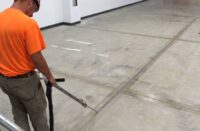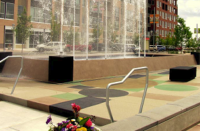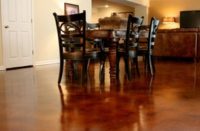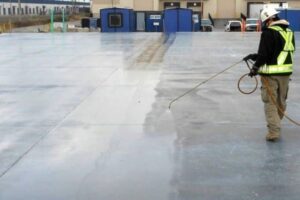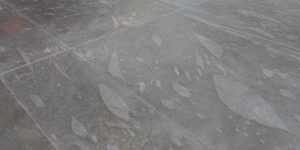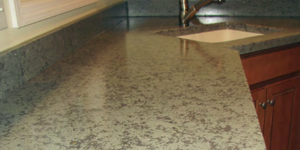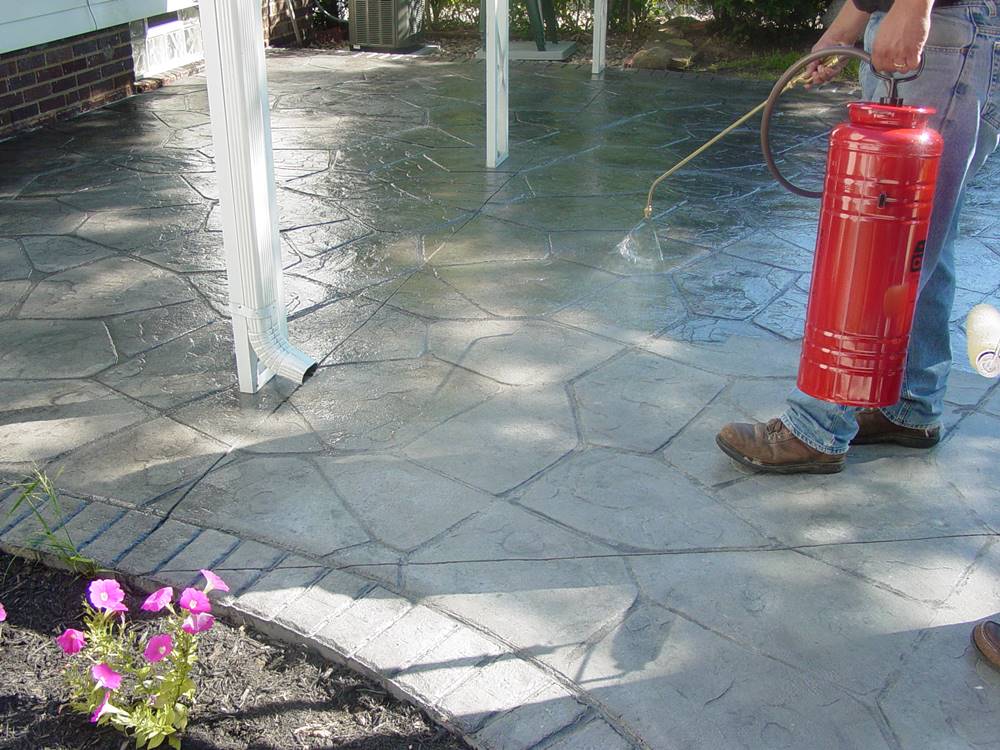
Concrete is one of the most durable building materials on the market. However, there are many factors that come into play when maximizing concrete’s strength and longevity. In fact, the steps taken after pouring the concrete have just as much impact on its durability as the concrete mix design and placement.
Concrete curing, a critical step in the durability process, helps to retain enough moisture and control temperature to support proper hydration — the chemical reaction between cement and water that forms a durable matrix to hold concrete together. In fact, laboratory tests show that concrete in a dry environment can lose as much as 50% of its potential strength, compared to similar concrete that’s moist cured. Likewise, concrete placed under high temperature conditions gains early strength quickly, only to later be reduced.
Allowing a long, slow hydration process results in concrete with optimal strength gain, surface hardness and freeze-thaw durability. This makes the concrete more likely to withstand surface wear and abrasion. Water will evaporate too quickly from freshly placed concrete not properly cured. It will weaken the concrete’s structural integrity, ultimately over time leading to issues like shrinking and cracking.
Here are five curing methods to protect concrete and maximize its service life:
Conventional methods for curing concrete
Applied externally to the concrete surface, conventional curing methods involve the application of water, coverings or membrane-forming liquids to slow water evaporation from the concrete.
There are several conventional methods for curing concrete — though the best option will depend on various factors, such as water availability, curing materials, labor constraints and weather conditions. A few high-level methods of curing new concrete include:
- Water curing by ponding, sprinkling or immersion
- Covering with wet burlap, plastic film or reinforced paper
- Applying a physical barrier, such as membrane-forming curing compounds or cure-and-seals

These conventional methods for curing concrete successfully fall into two stages: initial and final curing.
Initial curing
In the time between concrete placement and finishing, water can begin to bleed and evaporate from the surface. Once this water evaporates, the concrete will dry out. Initial curing aims to reduce moisture loss from the concrete surface during this crucial period. There are two main initial curing methods:
- Fogging provides excellent protection against surface drying by humidifying the air above concrete and replacing bleed water. This allows time for placing, striking-off and bull-floating operations. It also reduces the tendency for a crust to form on the surface of freshly placed concrete. You must use this method when the air temperature is well above freezing.
- Liquid-applied evaporation retarders, or water-based solutions of organic chemicals that form a very thin film layer over the bleed water, have been used as an initial curing method for decades. This film reduces the bleed water’s rate of evaporation from the surface. Once the finishing starts, take precautions to avoid mixing bleed water, fogging water or evaporation retarder into the slab. Without taking these precautions, you may risk creating a porous and weak concrete surface.
Final curing
After the finishing phase, once the concrete reaches its final set, the final curing begins. This involves water-based curing methods, such as sprinkling or ponding. Don’t use intermittent sprinkling if the concrete surface dries between periods of wetting, as it could stress and damage the new concrete. For these curing methods to be effective, air temperature must be above freezing and water in ample supply. Potential contamination of run-off to surrounding soils and streams should be considered.
Final curing materials, such as burlap or cotton mats, work as physical barriers to absorb and hold water on the surface. Some have an integral vapor barrier to help prevent drying, which provides sufficient long-term curing moisture to the concrete.
Similarly, rolls of reusable sheet-curing materials typically comprise less-absorbent, yet durable, synthetic fabrics that have a fairly long lifespan when properly used. Sheet-curing materials must lay flat on the new concrete to prevent shifting, damage and contamination.
Nonconventional methods for curing concrete
There are two nonconventional methods for curing concrete successfully: internal curing and the use of reactive silicate solutions.
Internal curing
Known informally as curing from the inside out, internal curing improves concrete’s performance by increasing the reaction of the cementitious materials. However, unlike conventional curing that supplies water from the surface of concrete, internal curing replaces some of the fine or intermediate aggregate within the concrete with prewetted lightweight aggregate.
Cementitious materials in concrete consume water within the slab as they chemically react, and concrete hardens. If the concrete has a lower water-to-cement (w/c) ratio, this reaction requires more water than is available. This causes the concrete to dry out, strength gain to cease and shrinkage cracks to form. Avoid this by using prewetted lightweight aggregate to supply additional water.
As the cementitious material hydrates, pores develop in the paste. These tiny voids cause the internal stresses that result in chemical shrinkage. The water-filled pores within lightweight aggregate are generally larger than the empty pores within the surrounding paste.
Thus, capillary pressure develops in the paste pores that enables moisture to draw out of the wetted lightweight aggregate and into the pores, keeping them saturated. This allows cementitious paste to continue to hydrate, gain strength, and fight off shrinkage and other deleterious effects of premature drying. Internal curing can yield a more robust concrete, especially for low w/c designs.
However, note that internal curing doesn’t replace conventional surface curing. The requirement for water retention at the concrete surface still exists with internal curing. Along with high-performance mixes, internal curing used in conjunction with surface curing can help compensate for less-than-ideal environmental conditions during placement.
Reactive silicate solutions as cures
The process of treating concrete with reactive silicate solutions dates back to World War II, when contractors used silicates to quickly strengthen the surface of new concrete runways on military bases. Water-based silicate solutions — when applied correctly — have no odor, residue or VOCs. They also dry quickly.
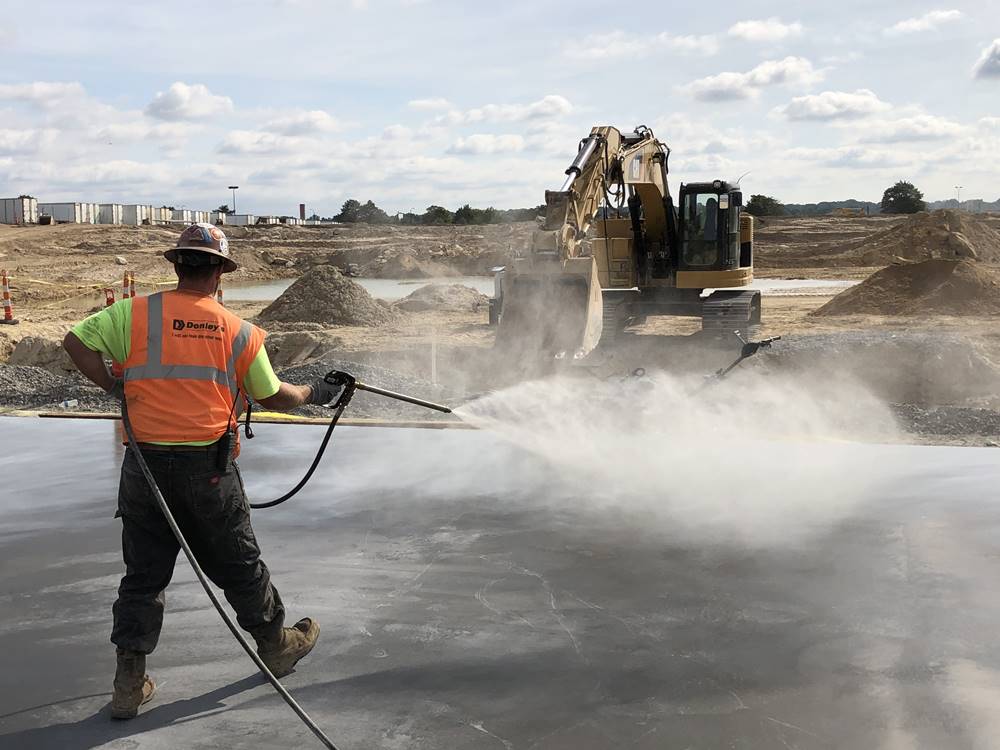
Silicates reduce concrete surface porosity, help prevent dusting and increase wear resistance. When applied to already cured, sufficiently aged concrete, a chemical reaction occurs between the silicate and excess calcium hydroxide within the surface to produce calcium silicate hydrate — the same binder that results from adding water to cement. It’s also the same material that gives concrete much of its strength and durability. Placing the newly created chemical compound in the surface pores leads to improved surface toughness.
There are many silicate solutions marketed today as suitable curing materials for fresh concrete. And many concrete placements have been treated with a silicate solution in lieu of a conventional curing method. When deciding whether to use a liquid curing material that doesn’t comply with industry standards, consider the environmental conditions expected during placement. Keep in mind that curing concrete with industry-leading materials provides insurance in the event that issues arise later.
